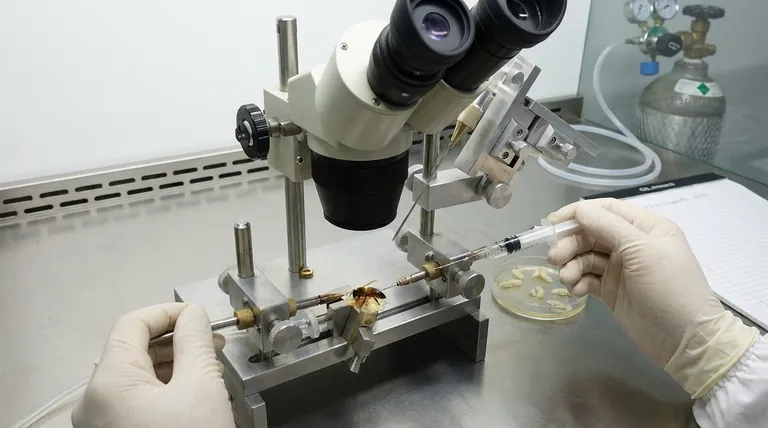The single most critical factor influencing queen quality for artificial insemination is the biological foundation of the queen herself, determined at the very earliest stage of her life. Specifically, the age of the larva at grafting is paramount; queens raised from larvae between 0-24 hours post-hatch develop superior reproductive systems, which is the bedrock of a successful insemination procedure.
While the technical procedure of insemination is a science, its success is ultimately determined by the biological potential of the queen. Focusing on her initial development from the youngest possible larva is the most crucial investment you can make.

The Foundation of Queen Quality: Early Development
A queen's capacity to be a productive, well-inseminated leader of a colony is established long before any insemination instrument is used. The conditions of her larval stage set a hard ceiling on her future potential.
The Critical Role of Larval Age
Queens produced from the youngest larvae, ideally those 0-24 hours old after the egg hatches, consistently show higher reproductive capacity. This is not a minor detail; it is a fundamental driver of quality.
These queens develop significantly larger ovaries and a larger spermathecal volume. This physical advantage is directly tied to the nutrition and developmental cues they receive in the first hours of their larval life.
Linking Biology to Insemination Success
The goal of instrumental insemination is to fill the queen's spermatheca with a sufficient volume of viable sperm. A queen with a larger spermatheca can physically hold more semen, directly increasing the probability of a successful, long-lasting insemination.
Starting with a queen who is biologically optimized for this task dramatically improves the odds of success compared to using a queen with a smaller, less developed reproductive system.
Technical Factors and Success Metrics
Beyond the queen's biology, the technical execution and subsequent evaluation are critical components of any professional insemination program.
The Importance of Proper Handling
Early insemination attempts used ether for anesthesia, which resulted in significant queen mortality. Modern best practice relies on CO2 narcosis, a far safer and more effective method for restraining the queen during the procedure.
This evolution highlights the importance of using refined, proven techniques to avoid harming the valuable queens you have carefully raised.
How to Measure Success
A key indicator of a successful insemination is the time until the onset of oviposition (egg-laying). Successful modern programs achieve results comparable to those of naturally mated queens.
Tracking this metric provides a reliable benchmark to evaluate and refine your technique, ensuring the inseminated queens are behaving as expected and are ready to lead a colony.
The Reality of an Insemination Program
Instrumental insemination is not a simple technique to be casually adopted. It is a demanding discipline that requires a significant and sustained investment.
The Demand for Advanced Skills
Success is built upon a foundation of advanced beekeeping skills. A deep understanding of queen rearing, colony management, and drone production is a prerequisite.
The Need for Significant Resources
This is not a low-cost endeavor. An effective program requires specialized equipment, dedicated resources for breeding and selection, and a considerable investment of time. It is labor-intensive and expensive.
The Requirement for Long-Term Commitment
Instrumental insemination is not a one-time task but a long-term program. It requires a sustained commitment to selective breeding, record keeping, and continuous improvement to realize its full benefits.
Key Focus Areas for a Successful Program
To apply this understanding, focus your efforts based on your primary objective.
- If your primary focus is maximizing biological potential: Prioritize grafting the youngest possible larvae (0-24 hours) to ensure every queen has the highest possible reproductive capacity from the start.
- If your primary focus is procedural excellence: Master the use of CO2 narcosis for safe handling and meticulously track the time to oviposition as your core success metric.
- If your primary focus is establishing a sustainable program: Honestly assess your resources, skills, and long-term commitment before investing, as this is a demanding and expensive discipline.
Ultimately, success in artificial insemination is a product of meticulous biological preparation and a deep, unwavering commitment to the craft.
Summary Table:
| Key Factor | Impact on Queen Quality | Optimal Practice |
|---|---|---|
| Larval Age at Grafting | Determines ovary & spermatheca size | Use larvae 0-24 hours old |
| Anesthesia Method | Affects queen mortality and safety | Use CO2 narcosis, not ether |
| Success Metric | Indicates viable insemination | Track time to onset of egg-laying |
| Program Commitment | Ensures long-term genetic gains | Requires sustained skill & resource investment |
Ready to Build a Superior Artificial Insemination Program?
The success of your queen rearing operation hinges on precision biology and reliable equipment. At HONESTBEE, we supply commercial apiaries and beekeeping equipment distributors with the high-quality, wholesale-focused supplies needed to support demanding insemination programs.
From specialized grafting tools to essential hive management equipment, we provide the foundation for your success. Let's discuss how our products can help you achieve your breeding goals.
Contact our expert team today to get started!
Visual Guide

Related Products
- Queen Bee Artificial Insemination Instrument Equipment for Instrumental Insemination
- Professional Queen Catcher and Introduction Queen Cage
- Plastic Chinese Queen Grafting Tool for Bee Queen Rearing
- Plastic Long Marker Device for Catching and Marking Bees Queen Bee Marking Tube and Cage
- Professional Spring-Action Queen Catcher Clip
People Also Ask
- What are the methods for controlling honey bee mating? Mastering Genetic Selection for Your Apiary
- What is the standard semen dose for AI of a honey bee queen? Master the 8-10 µl Precision for Longevity
- How is success of honey bee artificial insemination evaluated? From Oviposition to Long-Term Queen Quality
- What techniques have been used for semen mixing in artificial insemination? Master the Standard Protocol for Genetic Diversity
- What is the basic process of artificial insemination in honey bees? A Guide to Controlled Breeding for Superior Genetics



















